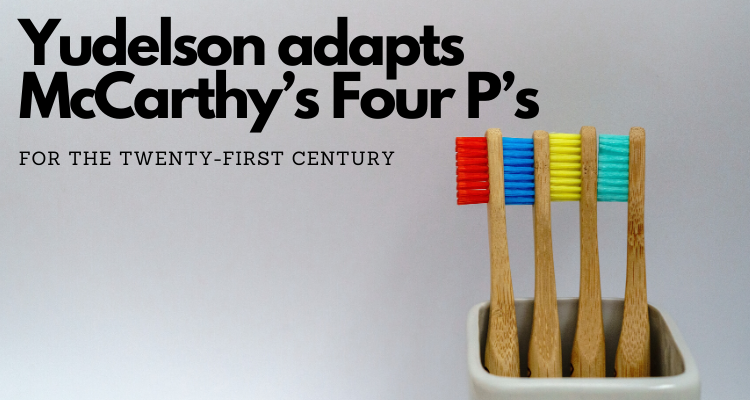Adapting the McCarthy’s Four P’s for the Twenty-First Century by Julian Yudelson is a rich modernisation of some of the founding marketing theories.
Contents
What are McCarthy’s Four P’s?
The main objective of this article is to redefine the 4P’s to the evolved, consumer-orientated business world. During the 60s and 70s the 4P’s consisted of 80% of MBA Marketing courses, it was estimated that by 2005 it would be only 20% (Lehmann 1997). Let us investigate this.
Updating McCarthy’s Four P’s for today’s marketing
The framework is questionably incomplete for the marketing practice of today; Yudelson believes not updating them suggests they are all that marketing requires. Yudelson acknowledges that Nichols and Woods (1997) stated that marketing is an evolving area and the initial 4P’s need to progress also. The crucial developments since the 1960s market of sales, advertising, and distribution include (Bartels 1962, 1988; Hunt 1983a, 1983b; Sheth, Gardner and Garrett 1988):
- Marketing focus has shifted to the consumer via the ‘Marketing Concept’
- Broadening the scope of business that use marking to include: not-for-profits, services, causes and politics
- Realisation that the exchange transaction is the ultimate element in marketing
- Establishment of Total Quality Management, with ‘customer satisfaction’ emphasised
- Extending transaction marketing to ‘relationship marketing’
- Inclusion of the firm as a participant of a complete value chain
Furthermore, Van Waterschoot and Van den Bulte (1992) documented shortcomings of the 4P’s: focus on doing to customers, than for; externally directed, ignoring internal market; lacks interfacing between mix variables; systematic understanding of markets; and presumes transactional exchange, than connections (Barker 1995). Yudelson acknowledges theorists’ attempts to rename and expand the 4P’s and that no satisfactory replacement model has evolved. Yudelson attempts to expand the definitions of the 4P’s.
Yudelson on the Marketing Mix
Yudelson redefines the original 4P’s defined by McCarthy’s Marketing Mix of Product, Price, Promotion and Place.
Marketing mix – Product
Product expanded to include all of the benefits a consumer will get from the exchange, not being the physical product or service itself, but the perceived benefits such as hope, beauty, holes, transportation, cost reduction, or eternal salvation. The recommended renaming is ‘performance’.
Marketing mix – Price
Price should be incorporated anything the consumer gives up in return for the benefits of the product, not just pecuniary values. Modernisation of this includes non-monetary prices such as time through a faster delivery. The modernised terminology for price is ‘penalty’.
Marketing mix – Promotion
Promotion comprises all information delivered to the consumers from the seller to finish the transaction, typically to show the benefit acquired from the interchange of product to price. The new phrase is ‘communications’.
Marketing mix – Place
Place is defined by all that needs to happen to action the exchange of desired products for price in the convenient locations where consumers wish. This has the potential of restrictions of physical location as place, when it should include online locations. This is especially so for digital information products. The fresh naming of Place is ‘process’.
Yudelson’s fifth P – Partners
Yudelson considers a required fifth element to complete his mix. This is ‘partners’, a business, consumer or donor in today’s world wishes to create a mutually advantageous long-term relationship, not just a sale. This implies that a seller appreciates the needs and penalty of the consumer.
McCarthy and Yudelson together in marketing
This article is a valuable resource to marketing students, professors, and practitioners alike. The article is built on the durable underpinning marketing theories of McCarthy, with the reminder that marketing is an evolving process and we must refine our approach and knowledge.
Although it updates the terminology to include modern-day, the key theories are still discovered in McCarthy’s Four P’s work. It is a valuable enhancement to the original article. Yudelson recognized that marketing focus has shifted to the consumer, Levitt also acknowledged this with his understanding that product-orientated marketing leads to product obsolescence.
Reference list:
Baker, Michael J., ed. 1995. Companion encyclopaedia of marketing. Lon- don: Routledge.
Bruner, Gordon C., II. 1997. Telephone conversation with the author.
Lehmann, Donald R. 1997. Some thoughts on the futures of marketing. In Reflections on the futures of marketing, by Donald R. Lehmann and Katherine E. Jocz, 121-35. Cambridge, MA: Marketing Science Institute.
Lehmann, Donald R. 1997. Some thoughts on the futures of marketing. In Reflections on the futures of marketing, by Donald R. Lehmann and Katherine E. Jocz, 121-35. Cambridge, MA: Marketing Science Institute.
Nichols, William G., and Marian Burk Woods. 1997. Marketing: Relationships, quality, value. New York: Worth.
Sheth, Jagdish N., David M. Gardner, and Dennis E. Garrett. 1988. Marketing theory: Evolution and evaluation. New York: John Wiley.
Van Waterschoot, Walter, and Christophe Van den Bulte, 1992, The 4P classification of the marketing mix revisited. Journal of Marketing 56, pp.83-93.Yudelson, Julian,. Adapting Mccarthy’s Four P’s for the Twenty-First Century. Journal of Marketing Education April 1999 vol. 21 no. 1 60-67
- Apple’s Steve Jobs Think Different / Crazy ones speech and advertising strategy - June 2, 2022
- Philip Kotler on Marketing and the 4 Ps - June 2, 2022
- Digital Marketing Predictions for 2023 - June 1, 2022




